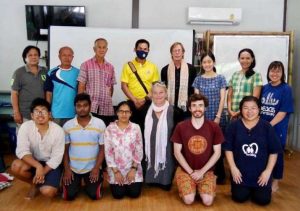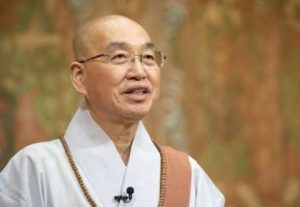
Last week I finally caught COVID-19 for the first time.
Over the past three years, there have been many times when I was sure I was going to catch the virus, having been in close proximity to people who had it, and each time I tested negative. So this was a bit of a surprise—especially since I received the Novavax vaccine a few days before coming down with symptoms; not enough time for it to reach full strength. I admit that in those few days during and after I was vaccinated, I was careless about wearing a mask in indoor public settings. This was a mistake and not how I’ve usually behaved during the pandemic. It doesn’t take much to get me on a soapbox about the benefits of masking up. I’ve usually been one of those folks who never fails to wear a mask inside grocery stores and other public places.
I’ve thought a lot about this virus over the past three years: the lessons it has offered us that we mostly don’t take on, and how it intersects with a Buddhist way of walking through life. The virus and I have had an intimate relationship. In January 2021, my mom and dad, who were in an assisted living center in Santa Fe, New Mexico, were exposed to COVID-19. By the end of that month, both of them had died. They were only a week away from being vaccinated when the exposure happened.
So this virus has taken a huge toll on my life, and has been a heartbreaking vehicle for deepening my understanding of impermanence. Yet I do my best to practice not seeing it as “the enemy.” This was a lesson that I learned from my beloved friend Katya, who was diagnosed with stage IV cancer only a couple of weeks after my mom’s death. In the seven months that I witnessed Katya living with cancer, she never once used the phrase “battle with cancer.” To her it was a “journey.” She didn’t view the cancer cells in her body as something to fight against, rather she was driven by a spirit of inquiry to understand why they might have been “confused,” and how she could support their healing. I bring this up because I think that Katya’s approach exemplifies what it means to look at this virus through a Dharmic lens.
At the heart of this pandemic is a virus that has been named SARS-CoV-2—a novel coronavirus. Over the past three years, we have learned to adapt our entire reality to the threat posed by this virus. Or at least some of us have. But thinking back to January 2020, when this was a small news story out of Wuhan, China—just a blip on our awareness—many of us may have assumed that it would fizzle out quickly and we’d continue living our lives as normal.
Around mid-February 2020, I remember seeing an alert from the US Center for Disease Control and Prevention, something to the effect of: anticipate significant disruptions to daily life activities and begin to prepare. I remember how ominous this warning felt, like something that should not be ignored. But most people minimized it. It was like a tsunami was building up at breakneck speed out in the ocean, even as the water right in front of us was calm, and our human tendency is to hang onto the appearance of calmness. Our addiction to the way things are is very strong.
Once the reality set in that COVID-19 was indeed a tsunami and was taking the lives of many people we loved, many of us moved into battle mode. Our common association with viruses is to see them as an enemy invader that ruins our body and that we must fight to eliminate. For many, the vaccine became the savior in this scenario—not for everyone, but that’s another story.
But is there another way to understand this virus? What happens when we view our life as not in opposition to anything, not even something that appears to be destroying our body?
I am reminded of a gathering that took place in New York City’s Union Square not long after 11 September 2001: a large group of people standing in a circle, many of them holding signs that read, “Our grief is not a cry for war.” What happens when we can sit with our loss, our grief, our anger, when we don’t react and turn them into a battleground for the “other,” whoever or whatever that other might be?
Consider this passage from the Chinese Chan master Hongzhi Zhengjue, as it appears in Cultivating the Empty Field, translated by Taigen Dan Leighton:
All Buddhas and every ancestor without exception testify that they all arrive at this refuge where the three times [past, present, and future] cease and the ten thousand changes are silenced. Straight ahead, unopposed by the smallest atom, the inherently illumined Buddha spirit subtly penetrates the original source. When recognized and realized exhaustively, [this spirit] shares itself and responds to situations. The gates sparkle and all beings behold the gleamings. Then they understand that from within this place fulfilled self flows out. The hundreds of grass-tips all around never are imposed as my causes and conditioning. The whole body from head to foot proceeds smoothly.
(A Buddhist Library)
Or, as my friend Roshi Joan Halifax likes to paraphrase it, not a single atom opposes us. What shifts when we approach COVID-19—or any illness—from this place?
Consider this alternate view: viruses can serve as catalysts for evolutionary processes. Viruses have been with us since the beginning of time, and we are not the same humans we used to be, in many cases because of viruses.
A 2016 article in Discover magazine by Nathaniel Scharping elaborates on this point:
Whenever a viral epidemic tears through a community, there are those lucky enough to possess mutations rendering them immune to the disease. If the epidemic is large enough, this mutation can become embedded in our genome, both because of its protective powers, and because those with it will be overrepresented in the surviving population.
Many of the genetic alterations wrought by viruses are still present in our genome today, and in a new paper, researchers at Stanford University suggests that as much as 30 percent of the adaptions seen in our proteins since the split with chimpanzees millions of years ago could be a direct result of viral infections.
(Discover)
Mind you I’m not trying to do a spiritual bypass here. I paid a terrible price because of this pandemic and many of you did too. But what if we widen our lens beyond our personal losses and try to find a different kind of meaning in what is unfolding?
The evolutions that viruses can provoke are not only biological, but social, cultural, and even spiritual. Mainstream media has tended to highlight the most negative developments in the wake of COVID-19, such as our deepening social divides. But what else has emerged? Increased opportunities to work from home, creative dining arrangements, and community mutual aid efforts to take care of one another outside of government or nonprofit structures are some of the gifts of this pandemic. We’ve had to learn how to live differently and many of those adaptations have been positive.
In the past year, there has been much talk about “getting back to normal,” but what does this really mean? Sure, the virus itself, plus shutdowns early on, had a detrimental impact on our economic and emotional health. But did we live in some kind of great world before COVID-19? What was “normal” like? Here are some pre-pandemic stats for the US:
• There was no state or county in the US where someone earning the federal minimum wage could afford a two-bedroom apartment.
• More than one in seven children—10 million—lived in poverty and in food-insecure households.
• 40 million people faced eviction.
• More than 2.2 million people were in prison, more than any other country.
If this is normal, I don’t want it. COVID-19 offered us a moment to step back and re-assess what our systems and structures have created. Mostly, we have declined that offer to reflect and change. But perhaps some opportunity still exists. We are invited to consider: what would it mean to live on this planet and with each other in a way that does not cause harm, that does good?

Finally, the very essence of a virus is that it relies on our interdependence. To be transmitted from one person to another requires our connection with each other. Small actions have huge consequences. I think of my mom and dad, and of the possible chain of actions that led to their infections and deaths. We are one body, this Earth body. Simple steps we can take, such as wearing a mask, can cut down on that transmission. But so many have refused or forgotten to take those steps, including me.
This will probably be a mild case of COVID-19 for me. Yet it’s not like that for everyone, especially those who are older and vulnerable in other ways. All we have to do is be conscious of our impact on one another, and we can take steps to reduce the spread of dis-ease and harm. Can we do that? Will we do that? I truly hope so. Let’s evolve together.
See more
Zen Teachings of Hongzhi Zhenjue (A Buddhist Library)
Viruses Have Guided the Path of Human Evolution (Discover)
Related features from BDG
Buddhistdoor View: All Manner of Healing in a Post-COVID Age
Buddhistdoor View: COVID-19 – Preparing for the End and Beyond
Buddhistdoor View: COVID-19 Knows No National Boundaries, Neither Should We
Facing the Challenges of COVID-19 Lockdown













May your brush with illness be light, and may your Dharma work continue!
Thank you, John, all better now!